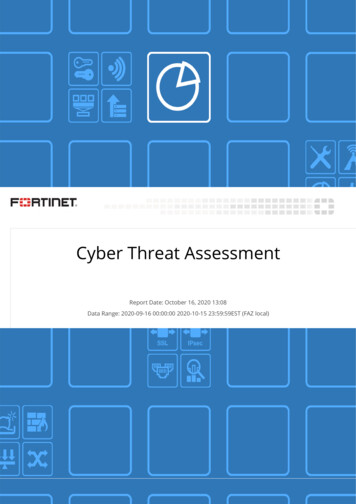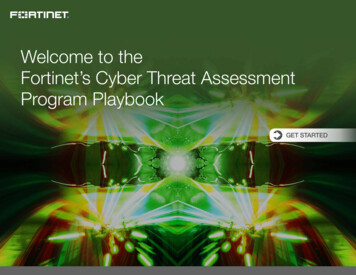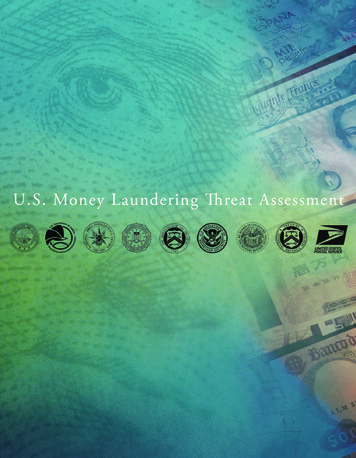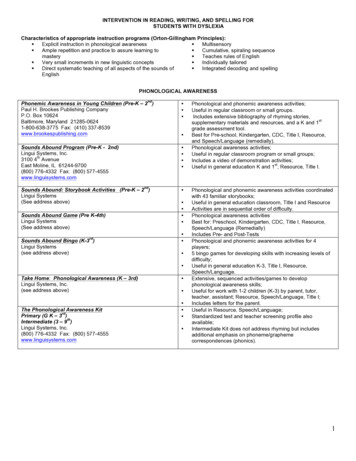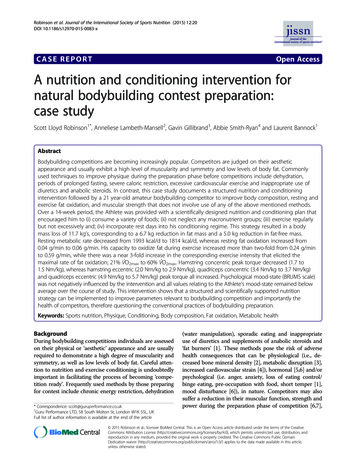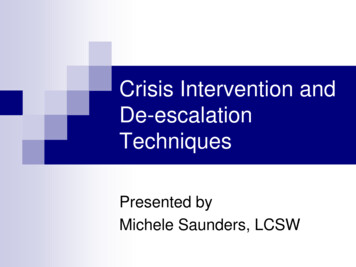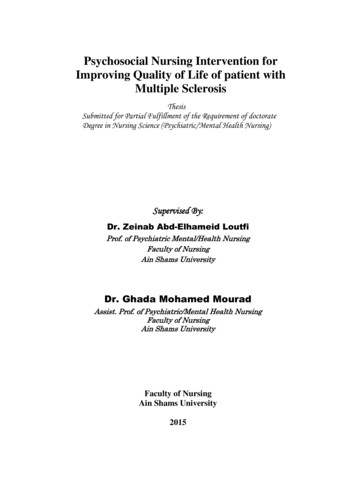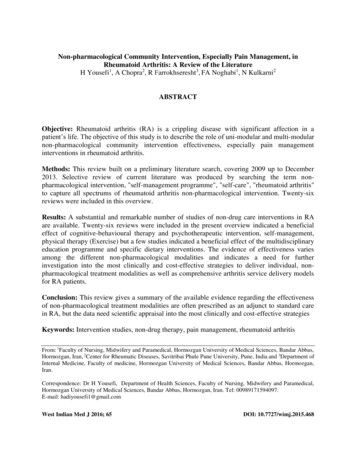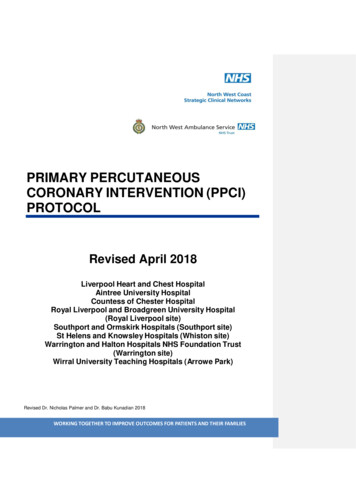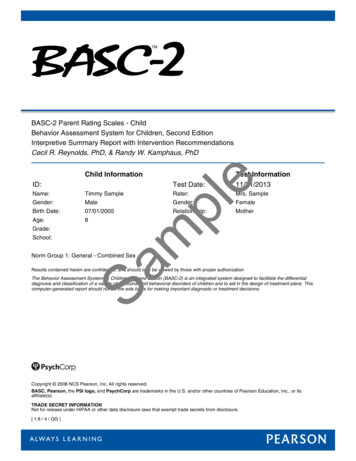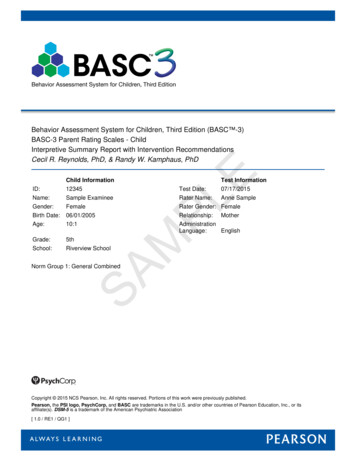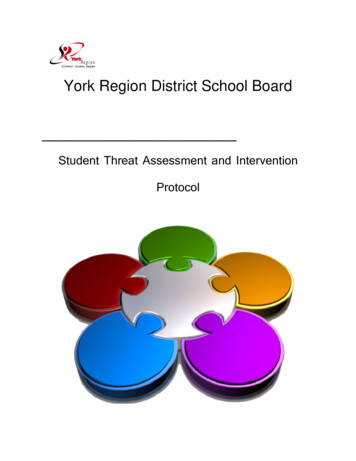
Transcription
York Region District School BoardStudent Threat Assessment and InterventionProtocol
DRAFT COPYJune 2012Advisor:Page2Kevin CameronExecutive Director, Canadian Centre for Threat Assessment and Trauma ResponseStudent Threat Assessment and Intervention Protocol
TABLE OF CONTENTSPageTABLE OF CONTENTSSECTION 1Purpose of ProtocolSECTION 2Defining Threat Assessment, Threats and Worrisome BehaviourSECTION 3Activating the Student Threat Assessment and Intervention ProtocolSECTION 4Three Stages of the Threat AssessmentSECTION 5Proceeding with a Stage I Threat Assessment and Intervention ProcessSECTION 6Stage II Threat Assessment and Multidisciplinary EvaluationSECTION 7Stage III Intervention PlanSECTION 8Responsible Information Sharing: Guidelines and LegislationSECTION 9Students with Special NeedsSECTION 10Locker SearchSECTION 11Creating an Expectation for Responsible Reporting and School Readiness344‐55‐677 ‐ 1213131414‐151515‐16APPENDICESWorrisome BehavioursStage I Interview FormIntervention Plan FormStage I Student Threat Assessment Incident ReportStage II Student Threat Assessment Summary ReportNotice of Student Threat Assessment formSchool Readiness: Guidelines for SchoolsFrequently Asked Questions (FAQ)Is parent/youth permission required to proceed with Threat Assessment?Who chairs a Threat Assessment Meeting?When should the threat-maker’s parents be contacted?When should the York Regional Police be called about a threat?Are Police contacted for students under 12 years of age who makes a threat?Can a Threat Assessment be activated for an exceptional student?Can the Principal search a student’s locker/backpack or purse?What information is shared with police at a Threat Assessment meeting?Are the contents of the OSR shared with police?Who reports knowledge of high-risk student behaviour?What is a Fair Notice Brochure?Who notifies the school community about a perceived threat?What is the difference between a Stage I and Stage II Threat Assessment?1819 ‐262728 ‐ 3031 ‐ 3233 ‐ 3435 ‐ 3738 ‐ 41Page3Appendix A:Appendix B:Appendix C:Appendix D:Appendix E:Appendix F:Appendix G:Appendix nt Threat Assessment and Intervention Protocol
SECTION 1 – Purpose of Protocol *The purpose of the Student Threat Assessment and Intervention Protocol is to guide theresponse to situations where there is information that indicates or suggests there is atargeted threat against an individual(s) and/or site(s).The protocol was developed to enable a community-based response to interveneeffectively to manage and reduce the risk of targeted violence. The emphasis of thisapproach is on prevention and the development of effective short and long-termintervention strategies in order to maintain a safe, caring and supportive school.SECTION 2 – Defining Threat Assessment, Threats and Worrisome BehaviourWhat is Threat Assessment?Threat assessment is the process of determining if a threat -maker (someone whoutters, writes, emails, etc. a threat to harm a target or targets) actually poses a risk tothe target or targets they have threatened. While individuals may engage in threatmaking behaviour, research indicates that few pose a risk to harm the target they havethreatened. Multidisciplinary threat assessment teams engage in a data collectionprocess including interviews and consultation with those who know the individualmaking the threat, to determine “initial level of risk” that may be posed and plannecessary risk-reducing interventions. The interventions are designed to protect anypotential targets as well as the individual making the threat.What is a Threat?A threat is defined as an indication of intent to do harm or act out violently againstsomeone or something. Threats may be verbal, written, drawn, posted on the internet,sent electronically or by information technology of any type, made by gesture orreasonably inferred from the surrounding circumstances of events. Threats may bedirect, indirect, conditional or veiled.Student Threat Assessment and Intervention ProtocolPage*This protocol document is not a substitute for training in the field of violence-threat risk assessment and individualsshould not engage in the threat assessment and intervention process until adequate training is received. TheStudent Threat Assessment and Intervention protocol is intended to be used by multidisciplinary teams trained in thetheory and practice of violence-threat risk assessment through “Level 1 Student Threat Assessment and Intervention4Threat-making behaviour is defined as any action that an individual, who in any mannerknowingly utters, conveys, or causes any person to receive a threat.
Training” program offered by the York Region District School Board, as certified by Lethbridge College and theCanadian Centre for Threat Assessment and Trauma Response.What are worrisome behaviours?Worrisome behaviours are those that cause concern for members of a school system.These behaviours may indicate that a student demonstrates a greater risk of violentbehaviour. This may include drawing pictures, writing stories, or making vaguestatements that do not, of themselves, constitute “uttering threats” as defined by law butcause concern for members of the school community because of their violent anddestructive content (refer to Appendix A).The goal of the threat assessment and intervention process is to prevent violence.Violence can also be prevented through early recognition of worrisome behaviours andthe development of an intervention plan to address these behaviours and reduce therisk that they will escalate to the point of threats and/or violence. Typically, a threatassessment would not be undertaken to address worrisome behaviours. Rather, amultidisciplinary intervention plan should be developed so that support can be put inplace for the student, before these behaviours warrant a threat assessment.SECTION 3 – When should the Student Threat Assessment and InterventionProtocol be activated?This Protocol should be activated in situations where: threats of violence are reported or observed, violence against others is reported or observed, or significant worrisome behaviours are reported or observed and an interventionplan has not been successful. In such cases, the worrisome behaviours are nottypical, and suggest that the individual is on a pathway to increasingly violentbehaviour against others.Page5When animmediateareriskunclear,is identifiedat a schoolsite, the schoollockdownplan withmust ldconsultactivated,trainedfollowed inbyStudenta call to 911as outlinedin the YRDSBEmergency PreparednessformallyThreatAssessmentand Intervention.procedures.Examples may include and are not limited to: a threat that is in the process of being acted out, such as someone setting up an explosivedevice, armed intruder, possession of a weapon, physical or sexual assault, evidence that a student has or can gain immediate access to a weaponIn these cases, a threat is posed and the matter is one of immediate police intervention and protectiveschool response: not Threat Assessment. Once immediate concerns regarding school safety and wellbeing have been addressed, proceeding with a threat assessment must be considered.Student Threat Assessment and Intervention Protocol
Activation of the Student Threat Assessment and Intervention Protocol by York Regional PoliceThere are times when a member of the York Regional Police receives information about a student thatwould warrant activation of the Student Threat Assessment and Intervention Protocol. YRP memberscan activate the protocol by contacting the Superintendent of Schools-Operation at 905-727-0022extension 2266.Automatic Activation of the Student Threat Assessment and Intervention Protocol for: serious violence with intent to harm or kill; verbal/written threats to kill others (“clear, direct and plausible”); internet website/MSN threats to kill others; possession of weapons (including replicas); bomb threats (making and/or detonating explosive devices); fire setting; sexual intimidation or assault; gang-related intimidation and violence.THREAT MANAGEMENT PLANNING CYCLECONCLUSIONORCONTINUEInformationsharing whilethe threat isimminent!INFOSHARING ‐VTRA0‐5HRS.MINRISK0‐10 REDUCTIONMIN STRATEGIES : Threat maker VictimLockdownSearch lockerNone, Some, All?CONTACTPOLICE 911Non‐EmergencyConsultPage6WHO ISAVAILABLERIGHTNOW ORRISOMEStudent Threat Assessment and Intervention Protocol
SECTION 4 – The three stages of the Student Threat Assessmentand Intervention processThe Student Threat Assessment and Intervention Protocol is comprised of three distinctand integrated stages involving a multidisciplinary team.Stage I consists of “data collection and immediate risk reducing intervention” initiated byschool staff. Data is then reviewed by others on the school team that must include theschool administrator, clinician, and York Regional Police. Data collection should beginimmediately when the administrator is made aware of the potential threat and shouldcontinue until all members of the team are assured that safety concerns have beenaddressed and there is enough information to develop an effective intervention plan.Stage II is further evaluation completed by a multidisciplinary team which may includesome or all of the following: York Regional Police, YRDSB Psychological Services staff,YRDSB Social Work staff, community-based mental health professionals, Children’s AidSociety staff, etc. This second stage is focused on comprehensive data collection forfurther identification of risk factors and effective strategies to reduce risk and providesupport to the student and othersStage III is the development and implementation of a comprehensive intervention planto support the student.SECTION 5 – Proceeding with a Stage I Student Threat Assessmentand InterventionThe Stage 1 Student Threat Assessment and Intervention process begins when a threatis reported to a school administrator. The administrator will proceed with the followingsteps to maintain safety at the school.Page7Step I: Identify the whereabouts of the target(s) and threat-maker(s) and addressany immediate risk factors. Appropriately monitor the individual(s) of concern. Prevent access to coats, backpacks, desks or lockers for those involved.Student Threat Assessment and Intervention Protocol
Step 2: Search of school property Administrators are permitted to search school property, such as lockers anddesks, without consent. Following the Police and School Board Protocol, Board employees will onlyconduct a search of an individual’s personal belongings such as knapsack,handbag, personal communication devices, personal computers andaccessories, etc., with the individual’s permission except where there wouldotherwise be an imminent risk of death or serious bodily harm.Step 3: Call York Regional Police to share initial data and request support for aThreat Assessment and Intervention meeting.Step 4: Convene the Stage 1 team The school administrator contacts police and clinician to convene a Stage 1 teammeeting. At the same time, school staff continues to collect data and continuesto assess risks to safety.Step 5: Collect and review data Review information collected from school records and sources related to theindividual such as internet use, notebooks, school assignments, informationcollected by the police, etc. as permissible (refer to Step 2).Step 6: Interview* Prior to conducting the Stage 1 Interview, the team should ask the followingquestions and act accordingly:1. How much time do we have?2. Who will be interviewed?3. In what order will we interview them?4. Who will interview them?Conduct interviews with potential target(s), threat-maker(s) and others such asfriends, parents, teachers (current and past), educational assistants, bus drivers,coaches, community agency staff members, etc. (refer to Appendix B for Stage IInterview form).Interviewing Students with Special NeedsPage8*When interviewing individuals with special education needs, English LanguageLearner needs, or disabilities, accommodations must be considered to support theindividual in his or her communication. Determine the need for an interpreter,including language interpreter and interpreters for hearing impaired students.Ideally, professionally qualified interpreters and not family or friends should beused with children/witnesses and individuals who require interpretative services.Student Threat Assessment and Intervention Protocol
Step 7: Notify the threat-maker(s) and target(s) parent/guardian(s)In accordance with the Education Act and accompanying regulations, a schooladministrator is responsible for reporting to a student’s parent or legal guardian. Theadministrator shall contact the student’s parent or legal guardian regarding the allegedinappropriate behaviour requiring police involvement unless the student is 18 years ofage or older and requests that his/her parents not be contacted, or if 16 or 17 years ofage and has withdrawn from parental control (refer to Police and School Board Protocol,Section 9 and 10).Parent/guardian permission is not required for a Threat Assessment to occur.Threat-maker Parent/Guardian notification:Parents/Guardians must be notified at the earliest opportunity. Administrators are obligated to inform theparents/guardians of an activity for which suspension or expulsion must be considered unless, in the opinion of theadministrator, doing so would put the student at risk of harm from the parents. Specifically, notification should occurafter the Threat Assessment and Intervention team has collected enough initial data to confirm that a threat orviolent act has occurred.The participation of parents/guardians in the threat assessment process is crucial since family members will be ableto provide important information about the threat-maker’s behaviour, activities, mental health, resources to carry outthe threat, peers, and other contextual information to determine the level of threat and develop a risk reduction plan.Parent/guardian notification may be delayed if:1. The student discloses child abuse during the Threat Assessment process. In this case school staff willnotify the appropriate child protection agency and work collaboratively with the agency as to the timing ofparent/guardian notification.2. The parent/guardian of the student has exhibited violent threatening behaviour in the past and is believed topose a potential risk to the safety and well-being of others. In this case school staff will enlist the support ofthe police, and the police member of the Threat Assessment team may opt to inform the parent/guardian.Target-Parent/Guardian notification:Page9If the threat is clear, direct and plausible, the targeted student’s safety must be addressed immediately. Theparent/guardian of the student(s) must be notified immediately after data is collected. That is, the student(s)who has been targeted should be secured and protected.Student Threat Assessment and Intervention Protocol
Step 8: Determine level of concernThe multidisciplinary Threat Assessment and Intervention Stage 1 team reviews theinformation and data gathered regarding the threat(s), behaviour(s) and the individual.As a team, there is a determination as to the level of concern that the individual poses. Low Level of ConcernRisk to the target(s), students, staff, and school safety is minimal.The categorization of low risk does not imply “no risk” but indicates the individualis at little risk for committing violence. Information indicates that the: threat is vague and indirect; threat is inconsistent, implausible or lacks detail and lacks realism; person is unlikely to carry out the threat of become violent; and/or behaviour of concern is within the general range for typical or baselinebehaviour for the individual in question.Ongoing monitoring of the matter is essential. Medium Level of Concern the threat is more plausible and concrete than a low level threat;the wording in the threat and information gathered suggests that somethought has been given to how the threat will be carried out (e.g., possibleplace and time);there is no clear indication that the individual of concern has takenpreparatory steps (e.g., seeking a weapon), although there may be anambiguous or inconclusive reference pointing to that possibility;there may be a specific statement indicating that the threat is not empty:e.g. “I’m serious!”;there is a moderate or lingering concern about the student’s potential toact violently, and/orthe behaviour or concerns represents an increase in baseline behaviour.A plan to monitor, support and decrease risk factors for violent behaviour mustbe developed.Student Threat Assessment and Intervention ProtocolPage 10The threat could be carried out, although it may not appear entirely realistic.Violent action is possible. Categorization at this level suggests that theindividual is at an elevated risk for violence, and those measures currently inplace or further measures, including monitoring, are required in an effort tomanage the individual’s future risk. Information indicates that:
High Level of ConcernThe threat or situation of concern appears to pose an imminent and seriousdanger to the safety of others. Categorization of risk at this level indicates thatthe individual is at a high or imminent risk for violence. Information indicates that: immediate intervention is required to prevent an act of violence fromoccurring;the threat is specific and plausible;there is an identified target;the individual has the capacity to act on the threat;concrete steps have been taken toward acting on the threat (e.g.,information indicates that the individual has acquired or practiced with aweapon or has had a victim under surveillance);information suggests strong concern about the individual’s potential to actviolently; and/orthere is a significant increase in baseline behaviour.It is essential in all high risk situations that a Stage 2 Student Threat Assessment andIntervention be conducted as soon as possible.*Sources for the above categorizations represent the work of the FBI, Durham Regional Police Service, Ontario Provincial PoliceThreat Assessment Unit, and the Canadian Centre for Threat Assessment and Trauma Response.Step 9: Decide on a Course of ActionLow to Medium Level of Concern Complete Intervention Plan Form (refer to Appendix C). Implement the Intervention Plan (Most students can be managed at schoolwith interventions). Medium to High Level of Concern Complete Intervention Plan Form (refer to Appendix C). The Threat Assessment and Intervention Team has determined that aStage II Threat Assessment and Multidisciplinary Evaluation is needed.Step 10: Complete Stage I Threat Assessment Incident Report Complete and submit Stage I Threat Assessment Incident Report(Refer to Appendix D)Student Threat Assessment and Intervention ProtocolPage 11With the input of all Threat Assessment and Intervention Team members, decide oncourse of action. If there is a low to medium level of concern, a student may bemanaged at school with appropriate (increased) supervision and support.
12PageStudent Threat Assessment and Intervention Protocol
SECTION 6 – Stage II Threat Assessment and MultidisciplinaryEvaluationThe second stage is focused on further data collection beyond the initial data setobtained in Stage I. This process will identify a more comprehensive understanding ofthe student and the risk factors that will inform an intervention plan (Stage III). Stage IIinvolves risk evaluation completed by a multidisciplinary team which may include someor all of the following: York Regional Police, YRDSB Psychological Services staff,YRDSB Social Work staff, community-based mental health professionals, Child
Prevent access to coats, backpacks, desks or lockers for those involved. SECTION 5 – Proceeding with a Stage I Student Threat Assessment and Intervention SECTION 4 – The three stages of

